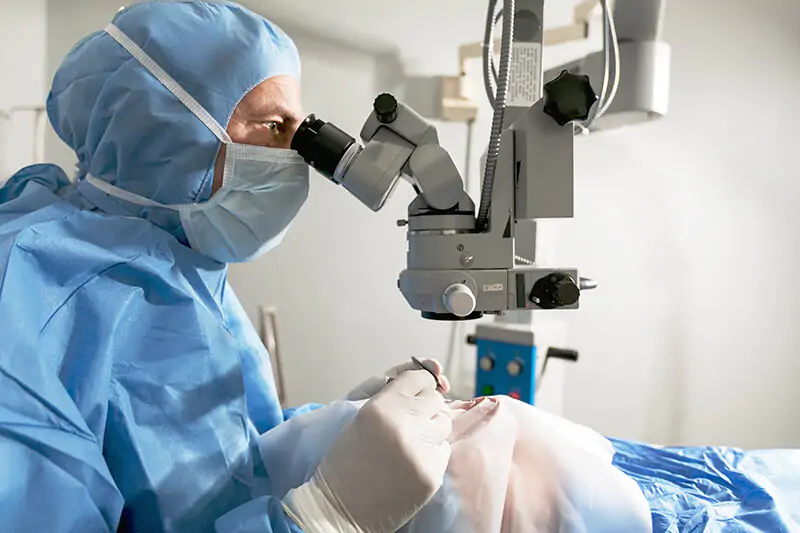حول الموضوع
مرض جفاف العين هو حالة لا تقوم فيها العين بإنتاج الدموع بالطريقة الملائمة، أو عندما لا تكون كثافة الدموع مناسبة وتتبخر بسرعة كبيرة. إذا تركت هذه الحالة دون علاج، فقد تؤدي إلى حدوث الالتهاب والألم والتقرح والتندب في القرنية وفقدان البصر.
يمكن لمرض جفاف العين أن يؤثر على نوعية حياة المصاب، فقد يؤدي إلى زيادة صعوبة القيام ببعض الأنشطة اليومية، مثل استخدام الكمبيوتر أو القراءة لفترة طويلة من الوقت، كما يمكن أن يقلل من درجة تحمّل البيئات الجافة، مثل مقصورة الطائرة.
هناك العديد من العوامل المرتبطة بمرض جفاف العين، وهو مرض مزمن يتطور تدريجياً ويؤدي إلى ظهور مجموعة من الأعراض وقد يؤدي إلى إتلاف العينين.


التشخيص
نستخدم أحدث التقنيات لتحديد السبب الرئيسي لأعراضك وتحديد حالة العين الجافة التي قد تعاني منها، بما في ذلك حالات مثل التهاب الجفن الأمامي والخلفي، وآفة ديموديكس، وجفاف العين التبخّري، وجفاف العين الناجم عن عوز الدموع، وغيرها من الحالات مثل مرض متلازمة شوغرن.
أدوات التشخيص المتطورة لدينا تشمل:
- تصويرالميبوغرافي للخلل في غدد ميبوميوس
- اختبار وقت تفكّك الدموع دون تدخّل جراحي،
- قياس سماكة طبقة الدهون،
- الارتفاع الهلالي الدمعي،
- قياس الأسمولية،
- اختبار (MMP 9) لتقييم الالتهاب.
الأعراض
لا يُبدي مرض جفاف العين مجموعة محددة من الأعراض، ويمكن أن يؤدي إلى ظهور أعراض مختلفة بدرجات متفاوتة الشدة عند مختلف الأشخاص، ولكن قد لا تظهر أي أعراض في المراحل المبكرة من المرض.
- إحساس لاذع أو حارق في العين
- إحساس ترابي أو رملي كما لو كان هناك شيء داخل العين
- نوبات من نزول الدموع بشكل مفرط بعد فترات تكون فيها العين جافة
- خروج إفرازات لزجة من العين
- ألم واحمرار العين
- نوبات من تشوش الرؤية
- ثقل الجفون
- عدم القدرة على البكاء عند الإجهاد العاطفي
- الإحساس بالانزعاج عند ارتداء العدسات اللاصقة
- انخفاض القدرة على تحمّل القراءة أو العمل على الكمبيوتر أو أي نشاط يتطلب الاهتمام البصري المستمر
- إرهاق العين
الأسباب
يصعب تحديد الأسباب الدقيقة لجفاف العين ويمكن أن تشمل مجموعة واسعة من العوامل المساهمة المحتملة بما فيها التغيرات الهرمونية والتقدّم في العمر والعوامل البيئية (المناخ الجاف والحار أو الإكثار من القراءة أو العمل على الكمبيوتر عندما يميل الناس لأن يطرفوا عيونهم بشكل أقل) وبعض الأدوية وجراحة العين بالليزر والعدسات اللاصقة وبعض الحالات الطبية، التي تتراوح من التهاب الملتحمة التحسسي إلى التهاب المفاصل الروماتيزمي.
جفاف العين هو مرض مزمن ولذا فإن العلاج يهدف إلى السيطرة عليه، حيث لا يوجد علاج شافٍ ولكن العلاج العرَضي يمكن أن يساعد المرضى على التمتّع بنوعية حياة أفضل.
- قطرات لجفاف العين المتخصصة
- علاج دوائي يؤخذ عن طريق الفم
- الحفاظ على صحة العين ونظافتها بشكل جيد
- المكملات الغذائية
- عمليات جراحية صغرى
- السدادات الدمعية (الدائمة وشبه الدائمة والقابلة للذوبان)
- إفراغ السوائل من غدد ميبوميوس بشكل يدوي
- (ليبي فلو(علاج بالحرارة لاضطراب الغدد الميبومية
- جلسات العلاج الضوئي كثيف النبضات
اطلب موعد




